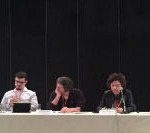Oct 8th, 2023

Richard Parker, researcher and professor at the Department of Sociomedical Sciences in the Mailman School of Public Health at Columbia University, and director of the Brazilian Interdisciplinary AIDS Association (ABIA).
Vivian Mannheimer| História Ciências Saúde Manguinhos
Over more than 40 years, the response to the Aids epidemic has had significant ups and downs. In the 1990s, the National Aids Program was reorganized, with significant dialogue and collaboration with civil society, and became a model for other countries, especially in the global South. However, in the past five years, the downgrading of the Brazilian Aids program was significant, and with the development of effective treatments for Aids, many people now think the epidemic has ended.
These and other issues were addressed in this interview with Richard Parker, researcher and professor at the Department of Sociomedical Sciences in the Mailman School of Public Health at Columbia University, and director of the Brazilian Interdisciplinary AIDS Association (ABIA).
Parker sees the future fight against HIV and Aids, whether in Brazil or globally, with concern. According to him, the current conditions in the world do not suggest that Aids will continue to be a significant priority for the global community or for the Brazilian government. According to him, the current conditions in the world do not suggest that Aids will continue to be a significant priority for the global community or for the Brazilian government.
Why is it important to discuss the history of Aids today in Brazil?
The history of Aids in Brazil strikes me as especially important for a number of reasons. Perhaps the most important (and intriguing) aspect is to understand why the response to the epidemic has had significant ups and downs over the course of more than 40 years now. Early in the epidemic, Brazil, like so many countries, was very slow to respond to the newly emerging epidemic, and when it finally did begin to respond, in the mid-1980s, that response was closely entwined with the redemocratization of Brazilian life after 20 years of military-authoritarian dictatorship.
In the 1990s, as the spirit of democracy was consolidated, the National Aids Program was reorganized and attracted support from the World Bank (which, for its part, was interested in increasing its investment in health and saw Brazil as a great opportunity). A renovated governmental response to the epidemic, with significant dialogue and collaboration with civil society, took shape by the end of the 1990s, following the implementation of a pioneering treatment access program that became a kind of model for other countries, especially in the global South. The success of the Brazilian program continued over the 2000s, but in the 2010s, it began to show signs of fragmentation and lack of commitment – problems that continued in different ways over the course of the Dilma, Temer, and especially the Bolsonaro administrations.
During the past five years, the disintegration and downgrading of the Brazilian Aids program was significant (although there is now hope that the new Lula government will gradually turn that around, at least partially). So, examining the history of Aids in Brazil can help us to understand both the conditions that help to create effective responses to the epidemic and those that lead to ineffective and counterproductive responses. It shows us that these conditions have to do with politics and economics and that domestic and international factors and influences are important and help determine the course of the epidemic.
Are you writing a book on this topic?
Yes, the book I am currently working on is actually a reflection of the global response to the epidemic over nearly 50 years now, but because of my long-term involvement in work on Aids in Brazil, I use the Brazilian experience as a kind of extended case study, in the sense that the sociologist, Michael Burawoy, has articulated. What happens in Brazil during different periods helps me illustrate and understand things going on internationally. In particular, I am interested in understanding how we have thought about the HIV epidemic over time and how changing understandings of it have shaped our responses.
The ways in which we have identified the different drivers of the epidemic have led to different kinds of responses, which are varied over time and space in the North and South. It has been tied into extremely important political and economic processes – issues such as the changing shape of global capitalism, the increasing intensity of globalization, the changing policy environment of neoliberalism, and even, in extremely important ways, the rise, and in some cases the fall, of democratic regimes and democratic principles. It has also been shaped by different approaches to collective health – by what I call ‘public health imaginaries.’
We often think of public health as if it were a kind of science that is not influenced by values and cultural understandings. Still, it is important to recognize that public health is also about ways of understanding the world that reflect cultural and political differences, and that is not always the same everywhere, so public health in Latin America or Brazil may not be the same as in sub-Saharan Africa or South Africa, and may not be the same as in the global North. These dissimilarities lead to important differences in how societies respond to public health emergencies and newly emerging public health conditions. For example, the ways public health or collective health in Brazil and other parts of Latin America have conceptualized possible responses to the epidemic are very different from how public health in its North American and European versions has responded to HIV and Aids.
One of the key things I’m interested in trying to understand is how alternative public health imaginaries have shaped very different responses in different parts of the global system. So, the book is about Aids in Brazil, but it’s also about Aids in the world and how the response to HIV in Brazil has been shaped both by global factors and historical traditions within Brazil and within the collective health imaginary.
How do you see the future fight against the disease?
Unfortunately, I would have to say that I am not especially optimistic about the future fight against HIV and Aids, whether in Brazil or globally. My concern is that the current conditions in the world do not suggest that Aids will continue to be a significant priority for the global community or, for that matter, for the Brazilian government.
When Aids first emerged in the 1980s, the world was in the closing years of the Cold War, and following the end of the Cold War, it went through a period of significant innovation and retooling, using the resources that previously had been consumed by war to try to respond to global developmental issues. That helped to make HIV and Aids a real priority globally, and it emerged by the end of the 1990s as perhaps the biggest development issue in the world.
The scale up of the global Aids response in the 2000s was a result of that prioritization, but by the end of the 2000s, we began to see other things emerging as bigger concerns. For example, following the global financial crisis from 2007 to 2008 or 2009, and extending into the next decade, we began to see how commitment to continuing the fight against HIV and Aids has begun to fall apart.
I’m especially critical of the way in which a narrative of the ‘End of Aids’ emerged in a way that actually covered up the end of scale up and a reduction in the priority that societies gave to responding to the epidemic. Most people have now realized that Aids is not about to end and that the fight to control the epidemic will need significant long-term commitments because it will be a slow go, but other priorities have already emerged, partly because of COVID-19, but also partly because of other major events such as the war in Ukraine.
Indeed, the anti-democratic climate that currently seems to be expanding around the world and the growing militarization, in some ways, resembles a return to the kind of Cold War era, albeit with new circumstances and particularities, at least in relation to when the epidemic first emerged, and it was so difficult to get societies to organize themselves to mobilize themselves to respond to it.
But I worry that in current conditions, with the rupture of liberal democracies, the return to a kind of arms race between opposing groups of countries, and the lack of commitment to issues such as health justice as a real priority, means that it will be very difficult to rebuild an effective response to Aids whether globally or specifically in Brazil. I would be very happy to be proven wrong, but these are the kinds of issues that give me concern for the future of the response to the epidemic.
Today, as there are already very effective treatments for Aids, and it is possible to “live with the virus”, many people think the epidemic has ended. Is it possible to say that the epidemic has come to an end? And if not, how close are we to the end of the Aids epidemic?
I already partially anticipated the response to this question in the last few points I raised in response to the previous question. But I appreciate this question about the end of Aids because it gives me a chance to be just a little more specific about what my concern is. I think that it is important to have what we might call ‘aspirational goals’ in any field of work, and certainly in relation to collective health and global health.
For that reason, it was important, for example, for the World Health Organization to create the goal of ‘Health for All in the Year 2000’ as an aspirational goal for the international system to try to strive for – even though I think that most people understood back in 1978, at the conference in Alma Ata, that ‘health for all’ was unlikely to be achieved by the date suggested. In this sense, I recognize the importance of trying to set aspirational goals in relation to a health crisis like HIV and Aids, and goals such as the end of Aids or the cure of Aids are extremely important.
I think back to the short article (crônica) that Herbert de Souza published in the Jornal do Brasil in the early 1990s called ‘The Cure of Aids’, in which he imagined waking up one day as a person living with HIV to hear the announcement that the cure of Aids had been discovered, and how his world would change, how our world would change, because of that cure. He emphasized the importance of continuing to believe in the possibility of a cure because it helps us keep going, fighting, and living in the face of often very difficult circumstances.
So, I think that the end of Aids is an aspirational goal is an important goal it’s certainly a goal that I share, and that helps me to keep doing the work that I do. But an aspirational goal is different from a false promise. In this world of advertising slogans, in a world of simplistic Twitter messages, I am sad to say that I think the end of Aids was treated as a promise (and a false one!)– indeed, we even had an exact date, 2030, when the sustainable development goals end. We were promised that Aids, too, would end, which, of course, it won’t. So, what I object to is not the aspirational goal; what I object to is an aspirational goal being treated like an advertising slogan.
I’m convinced that if we ever hope to revive the kind of approach to the Aids epidemic that has any chance of truly leading to the end of Aids, we need to begin to rethink the way we approach the epidemic and return to a prioritization of human rights and social justice – issues that have seemingly been forgotten – as opposed to false promises about biomedical silver bullets. Ending Aids will require significant social changes, it will require addressing the structural violence and social inequalities that have been the true drivers of the epidemic and false promises about an end of Aids that is just around the corner if we continue to believe in biomedical solutions produced by the pharmaceutical industry (and producing great profits for the pharmaceutical industry) if we have to have any hope of truly striving for the end of Aids.
Whether or not this will be possible in the world that we currently live in, time will tell, but these are the kinds of issues that I think we need to focus on and try to commit to if we are going to be able to make real progress in rebuilding an effective response to HIV and Aids, whether in Brazil or globally.
How to cite this interview:
Parker, Richard. The history of Aids epidemic in Brazil: have we reached the end of it? História, Ciências, Saúde –Manguinhos (Blog). Accessed on [date].
The Aids epidemic in HCS-Manguinhos:
Successes and setbacks in the fight against Aids The medical anthropologist Richard Parker, professor at Columbia University, examines the social and political aspects of HIV/AIDS in Latin America.
AIDS in historical perspective To mark the World AIDS Day, we have prepared a selection of articles, posts and stories that address different aspects of the history of AIDS, such as the decline of the AIDS program in Brazil, the successes and setbacks in the fight against Aids, public health campaigns, the response of international institutions and much more.
AIDS, Activism, and International Agencies in Brazil, 1987–1996 Marcos Cueto, Science editor of HCSM, published with Gabriel Lopes, “Braiding Public Health and Human Rights: AIDS, Activism, and International Agencies in Brazil, 1987–1996” Latin American Research Review (2022). This article examines the emergence of a synergy that allowed the early development of what was once considered the best anti-AIDS program in the developing world.
A global player in the politics of Aids Marcos Cueto, science editor of HCSM, and Gabriel Lopes, postdoctoral researcher at Casa de Oswaldo Cruz (Fiocruz), explore the Brazilian participation in international debates on whether antiretroviral drugs were commodities or public goods.
HIV/AIDS, its stigma and history Our science editors André Felipe Cândido da Silva and Marcos Cueto discuss the HIV prevention policy adopted in Brazil since December 2017: the pre-exposure prophylaxis.







